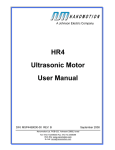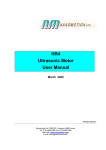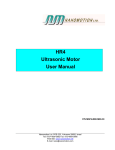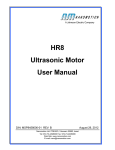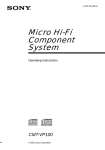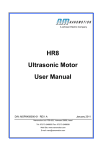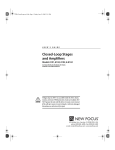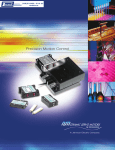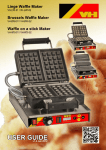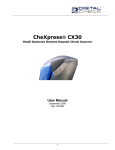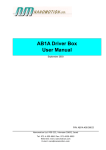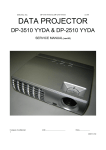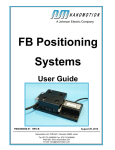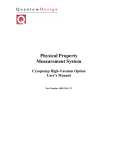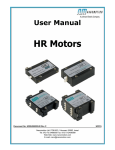Download HR2 Ultrasonic Motor User Manual
Transcript
HR2 Ultrasonic Motor User Manual D/N: MSP2458000-00 REV: B Nanomotion Ltd. POB 623, Yokneam 20692, Israel Tel: 972-73-2498000 Fax: 972-73-2498099 Web Site: www.nanomotion.com E-mail: [email protected] September 2008 Copyrught and Limited Warranty Copyright April 2000. This document contains proprietary information of Nanomotion, Ltd. and may not be reproduced in any form without prior written consent from Nanomotion Ltd. Limited Warranty Nanomotion (hereinafter NM) warrants the product (other than software) manufactured by it to be free from defects in material and workmanship for a period of time of one year (except those parts normally considered as consumable/expendable components such as motor conditioning brushes). The warranty commences thirty (30) days from the date of shipment. NM warrants those parts replaced under warranty for a period equal to the remaining warranty coverage of the original part. NM’s sole and exclusive obligation under this warranty provision shall be to repair, or at its sole option exchange defective products or the relevant part or component, but only if : (i) the Purchaser reports the defect to NM in writing and provides a description of the defective product and complete information about the manner of its discovery within ten (10) days of its discovery; (ii) NM has the opportunity to investigate the reported defect and determines that the defect arises from faulty material, parts or workmanship; and (iii) the Purchaser returns the affected product to a location designated by NM. These provisions constitute the exclusive remedy of the Purchaser for product defects or any other claim of liability in connection with the purchase or use of NM products. This warranty policy applies only to NM products purchased directly from NM or from an authorized NM distributor or representative. This warranty shall not apply to (i) products repaired or altered by anyone other than those authorized by NM; (ii) products subjected to negligence, accidents or damage by circumstances beyond NM control; (iii) product subjected to improper operation or maintenance (i.e. operation not in accordance with NM Installation Manuals and/or instructions) or for use other than the original purpose for which the product was designed to be used. The warranty stands only when the motors are used with the NM drivers/ amplifiers. NM shall not in any event have obligations or liabilities to the Purchaser or any other party for loss of profits, loss of use or incidental, increased cost of operation or delays in operation, special or consequential damages, whether based on contract, tort (including negligence), strict liability, or any other theory or form of action, even if NM has been advised of the possibility thereof, arising out of or in connection with the manufacture, sale, delivery, use, repair or performance of the NM products. Without limiting the generality of the preceding sentence, NM shall not be liable to the Purchaser for personal injury or property damages. Nanomotion Ltd. Page 2 of 30 CE Compliance CE Compliance The motors and drivers comply to the following directive: Safety : IEC 61010-1:1990 EMC : 89/336/EEC as amended by 92/31/EEC and 93/68/EEC Harmonized Standards to which conformity is declared: EN 50081- 2:1993/EN 55011:1991 Generic Emission Standards Class A for radiated emission and Class B for conducted emission. EN 50082- 2:1995 Generic Immunity Standard NOTE: UHV motors are designed for convenient interface to the UHV setup. The motors are therefore supplied with three open electrical leads. Whereas standard motors comply with CE regulations and the UHV motors have the same internal design as standard motors, the UHV motors are supplied as components and CE conformity in both EMI and Safety must be implemented as part of the UHV system design. Nanomotion Ltd. Page 3 of 30 Definition of Terms and Warnings Preface This Installation Manual is designed to help the reader install and operate the various types of Nanomotion’s HR2 piezoceramic Motors. This manual assumes that the reader has a fundamental understanding of basic servo systems, as well as motion control concepts and applicable safety procedures. The manual describes the physical dimensions as well as the mechanical and electrical installation procedures for these motors. Warranty The motors are covered by warranty for a period of twelve months from the date of invoice. The following voids the warranty: Misuse or incorrect mounting, incorrect electrical connections, removal of motor cover or of serial number, modification of parts, and any other use that is not according to the cautions and warnings provided in this guide. Liability for replacement will be determined after inspection of any defective item by Nanomotion or an approved agent. Nanomotion Ltd. Page 4 of 30 Definition of Terms and Warnings Definition of Terms NOTE: Additonal usefull information. CAUTION: Identifies conditions or practices that could result in damage to this product or other property. WARNING: Identifies conditions or practices that could result in personal injury, damage to the product or damage to other property. Warnings and Cautions WARNINGS Do not remove the cover of the motor or disassemble its connector. High voltage inside. Be sure to ground the motor to the electrical network ground (according to the following instructions) before operating the motor. CAUTIONS § Arrows on motor indicate direction of motion. Align accordingly. § Do not set power-on unless motor is mounted and preloaded! Do not immerse the motor in any liquid or cleaning agent. § § § Nanomotion Ltd. Use only a clean cloth to wipe the motor. Be sure that the motor, and specifically the 'finger tips', are not subjected to mechanical shocks. § Be sure that the distance of the motor to the plate enables the motor finger tip to contact the driving plate, otherwise the motor might be damaged during operation. § The mounting base and the method used for mounting should be designed for maximum mechanical rigidity and stiffness. § Reducing the length of the supplied motor cable may damage the motor. Do not attempt to shorten the cable without prior confirmation by Nanomotion. § Extending the motor cable will not damage the motor, however it will affect its performance. Page 5 of 30 Table of Contents Table of Contents 1. 2. INTRODUCTION............................................................................................................7 1.1 About the Motor ..............................................................................................7 1.2 Vacuum Motors...............................................................................................7 1.3 HR2 System Parts...........................................................................................8 1.4 Handling ..........................................................................................................8 1.5 Installation and Servicing...............................................................................8 PREPARATION AND INSTALLATION..........................................................................9 2.1 Preparation......................................................................................................9 2.1.1 Mounting Base................................................................................................10 2.1.2 Limiting Stage Motion .....................................................................................11 2.2 Motor Installation..........................................................................................11 2.2.1 Bonding the Driving Plate to the Stage ...........................................................12 2.2.2 Mounting the Motor.........................................................................................15 2.2.3 Motor Grounding.............................................................................................17 2.2.4 Motor Connections..........................................................................................17 2.2.4.1 Motor Connector Pinout ..................................................................................18 2.2.4.2 System Electrical Configuration ......................................................................19 2.2.5 3. Motor Run-In...................................................................................................19 SPECIFICATIONS .......................................................................................................20 3.1 General ..........................................................................................................20 3.2 Specification Parameters .............................................................................22 3.2.1 Performance ...................................................................................................22 3.2.2 Electrical .........................................................................................................22 3.2.3 Environmental.................................................................................................22 3.2.4 Physical Dimensions.......................................................................................22 3.2.5 Performance Envelope with the AB5 driver.....................................................23 3.2.6 Performance Envelope with AB1A, AB2, AB4.................................................25 3.3 Schematics....................................................................................................28 3.3.1 Dimensions for Standard and High-Vacuum Motors .......................................28 3.3.2 Dimensions for Ultra-High-Vacuum Motors ....................................................29 3.3.3 Mounting Base Dimensions ............................................................................30 Nanomotion Ltd. Page 6 of 30 Introduction 1. Introduction 1.1 About the Motor The HR2 motors are high precision ceramic motors. Designed and manufactured by Nanomotion, Ltd., the HR2 motors combine unlimited stroke with high resolution in compact dimensions. Among its applications are microscopy, precision motion, robotics, etc. The motors provide a linear response to the input voltage. The operation of the motor and driver resembles that of a DC-motor driven by a voltage amplifier. The specifications described in this chapter apply only to the motor driven by AB1A Driver. Minor differences may result if AB2, AB4 or AB5 are used. 1.2 Vacuum Motors Applications of the Nanomotion motors for vacuum and highvacuum environments include wafer inspection metrology, scanning stages and lithography. The HR2-V and HR2-U motors are constructed of materials that have been selected and designed for high vacuum compatibility. Nanomotion Ltd. Page 7 of 30 Introduction 1.3 HR2 System Parts A complete set for a single axis will comprise of the following: a) HR2 Motor b) 1.8mm spacer c) Ceramic Driving Plate for linear applications or Ceramic Driving Ring/Disk for rotary applications. (see section 2.2.1) d) One of the following drivers: § AB1A § AB2 § AB4 § AB5 NOTE: For the first 4 driver options, use a standard off-the-shelf DC Controller with a servo rate of 10KHz or higher. You may consult Nanomotion for the recommended controller. The option for NCD Driver Controller Box consists of a driver and an integrated controller. 1.4 Handling CAUTIONS Do not set power-on unless the motor is mounted and preloaded! Do not immerse the motor in any liquid or cleaning agent. Use only a clean cloth to wipe the motor. Be sure that the motor, and specifically the 'finger tips', are not subjected to mechanical shocks. 1.5 Installation and Servicing It is recommended to follow the installation instructions in this guide, when mounting and installing the motor. The HR2 does not contain any user-serviceable parts. Nanomotion Ltd. Page 8 of 30 Preparation and Installation 2. Preparation and Installation 2.1 Preparation For optimal motor performance, it is recommended to use the Ceramic driving plates provided by Nanomotion. These driving plates have been specifically designed to work with Nanomotion motors. Substituting this plate with any other material might reduce motor performance or damage the motor. NOTE: The instructions given in this section refer to the standard ceramic driving plates provided by Nanomotion. Nanomotion can not guarantee performance attained by plates purchased from other sources. Nanomotion Ltd. Page 9 of 30 Preparation and Installation 2.1.1 Mounting Base Prepare a base with four oval holes as described in Section 3.2.8 Mounting Base Dimensions. The base should be positioned perpendicular to the Ceramic driving plate that is bonded to the stage. If necessary, refer to the schematic for motor dimensions. CAUTION: The mounting base and the method used for mounting should be designed for maximum mechanical rigidity and stiffness. Stage Carriage Ceramic Driving Plate location Stage Base Mounting Base 4x oval holes Figure 1: Motor Mounting Base The mounting base dimensions diagram refers to the front surface of the Ceramic driving plate. For driving plate dimensions please refer to the price list. The four screws securing the motor to the mounting surface will be inserted from its underside. Any protrusion of the screws might interfere with motion on another axis. Nanomotion Ltd. Page 10 of 30 Preparation and Installation 2.1.2 Limiting Stage Motion The provided ceramic driving plate should not exceed the stage. It must be supported by a solid even backing along all its length, in order to avoid breaking when motor is pressed against it. The Ceramic driving plate should also be at least 10 mm longer than the stage travel length, otherwise the motor finger tips might be damaged. If the above requirements are not met, limit the stage travel distance using end stops. 2.2 Motor Installation The installation procedure consists of the following: Nanomotion Ltd. § Bonding the Ceramic Driving plate to the stage § Mounting the motor § Grounding the motor § Connecting the motor to its driver Page 11 of 30 Preparation and Installation 2.2.1 Bonding the Driving Plate to the Stage The Driving Ceramic Plate interfaces between the motor 'finger tips' and the stage, and provides the required friction. Bond the driving plate provided by Nanomotion to the stage surface interfacing with the motor 'finger tips', according to the instructions given in this section. S tag e A lu m in a D riv in g P la te Figure 2: Bonding the Ceramic Driving Plate Nanomotion Ltd. Page 12 of 30 Preparation and Installation 1. Clean the bonding region on the stage, using a suitable agent such as Acetone or Methanol. 2. Peel off the self-adhesive backing paper on the Ceramic driving plate. The self adhesive tape is compatible with high-vacuum applications. 3. Referring to the figure below, place the plate in position, verifying that: § There is a maximum of 2.0mm between the lower edge of the Ceramic driving plate and the motor mounting surface. § There is a minimum of 11.0mm between the upper edge of the Ceramic driving plate and the motor mounting surface. Alumina driving plate Mounting Surface 11 mm (min) 2.0 mm (max) Figure 3: Ceramic Driving Plate Position Continued on the following page…. Nanomotion Ltd. Page 13 of 30 Preparation and Installation 4. Referring to the figure below, apply two drops of epoxy adhesive, on the center of the Ceramic driving plate upper surface, about 2cm apart. The Epoxy must bond between the plate and the stage. Recommended adhesive: § Emerson & Cuming ecobond 24, for vacuum applications § 3M 2216 epoxy or CIBA GEIGEY Arldite Radite, for nonvacuum applications NOTE: Be sure the epoxy contacts the upper surfaces of the plate and the stage carriage but does not flow over the Ceramic plate front surface. Stage 2 cm Epoxy Alumina Plate Figure 4: Securing the Ceramic Driving Plate to the Stage 5. Allow the required time period for curing, according to the Epoxy manufacturer specifications. 6. Mount the motor according to the following section. Nanomotion Ltd. Page 14 of 30 Preparation and Installation 2.2.2 Mounting the Motor After bonding the Ceramic driving plate to the stage, loosely mount the motor so it faces the Ceramic driving plate according to the instructions in this section. NOTE: The motor does not have an 'up' or 'down' side and may be mounted on either surface so that the cable protrudes from either the left or the right side. Stage Mounting Base Spacer Allen key M3 socket head screws For M3 Motor Figure 5: Accessories for mounting 1. Align the motor to the four holes on the motor mounting surface. 2. Secure the motor to the surface using four M3 screws and spring washers inserted from the underside of the mounting surface. Do not tighten yet. 3. Adjust the distance between the motor and the Ceramic driving plate as follows: § Place the 1.8 mm spacer between the motor surface that faces the Ceramic driving plate, and the Ceramic driving plate. § Gently press the motor against the Ceramic plate to the thickness of the spacer. § Lightly screw the four motor screws and then remove the spacer. § Fully tighten the motor screws at a torque of 0.5 to 0.7Nm. 4. Ground the motor according to the following section. Nanomotion Ltd. Page 15 of 30 Preparation and Installation Insert M3 screws. Do not tighten yet Figure 6: Inseting screws Insert spacer between motor and ceramic drive strip. Press the motor against the spacer and tighten the screws. Pull spacer out. Figure 7: Spacing and tightening Nanomotion Ltd. Page 16 of 30 Preparation and Installation 2.2.3 Motor Grounding Warning !!! Be sure to ground the motor to the electrical network ground (according to the following instructions) before operating the motor. 1. Prepare a grounding wire and a terminal connection with the following specifications: § Terminal diameter - for an M3 screw § Wire diameter - minimum 18 AWG § Wire length - maximum of 2 meter 2. Open the motor ground screw (figures 15 & 16) and connect the ground connection prepared in step-1. 3. Secure the terminal between the two lock washers. 4. Connect the other end of this cable to the electrical network ground. 5. Connect the motor to its driver according to the instructions given in the following section. 2.2.4 Motor Connections This section describes the motor connector pinout and the connections to each of the available drivers. Make sure the driver is set to operate with the HR2 motor series. CAUTIONS: Reducing the length of the supplied motor cable may damage the motor. Do not attempt to shorten the cable without prior confirmation by Nanomotion. Extending the motor cable will not damage the motor, however it will affect its performance. Nanomotion Ltd. Page 17 of 30 Preparation and Installation 2.2.4.1 Motor Connector Pinout WARNING: Do not remove the cover of the motor or disassemble its connector. High voltage inside. CAUTION: Do not set power-on unless the motor is mounted and preloaded. The motor driver connection is a standard 9 contacts D-type female connector whose pinout is given below. Connector Motor Red Direction 1 Common Direction 2 Screen Black White Shield Pinout 5 9 4 8 3 7 2 6 1 Figure 8: Motor Connector NOTE: Pins 6 and 1 on the motor connector are shorted . This is done for safety reasons – driver voltage is disabled unless pins 1 & 6 are shorted when motor is connected. For Ultra High Vacuum motor: The HR2 –2-U motor does not have an outlet cable or a connector. Instead, there are 3 TFE jacketed wires extending outside the motor: 1 black wire, 1 red and 1 white wire. The red and white wires are directions 1 and 2 respectively, and the black wire is the common. Also, the safety shorting between pins1 and 6 is not implemented and should be preformed by the user. WARNING Since there is no cable shielding the HR2-2-U motor case to the ground, it must be grounded by means of connection to the network ground. Please refer to section 2.2.3 in the manual for detailed instructions. Nanomotion Ltd. Page 18 of 30 Preparation and Installation 2.2.4.2 System Electrical Configuration The Motor is to be operated by one of Nanomotion’s drivers. Following is the two possible configurations: Nanomotion’s Driver Without an Integrated LC circuit LC Box Motor Figure 9: Connection to a driver using an external LC box Nanomotion’s Driver With an Integrated Internal LC circuit Motor Figure 10: Connection to a Driver with internal LC circuit 2.2.5 Motor Run-In Run-in of the motor is important to reduce wear rate of the system and to increase its lifetime. The required run-in conditions are as follows: § velocity - 100 mm/sec. § Duty cycle - 50%. § Duration - 4 hours. When the run–in is completed, carefully clean the ceramic strip with a Q-Tip soaked with IPA, without dismounting the motor. General remarks: 1. The procedure should be repeated if the motor is disconnected and then reinstalled. 2. Do not perform run-in in a vacuum environment. Nanomotion Ltd. Page 19 of 30 Specifications 3. Specifications 3.1 General These specifications apply to the standard motor driven by the AB1A Driver Box. The motor features a linear voltage response. The motor and driver can be modeled as a DC-motor with friction driven by a voltage amplifier, as illustrated in the following diagram. . Offset Vin + + Kf - 1/M 1/S Vel Kfv Figure 11: Block Diagram of the Motor and Driver Where: Nanomotion Ltd. Vin - Command to the driver -10 to +10 [V] Kf - Force constant [N/V] Offset - Starting voltage [V] Kfv - Velocity damping factor (similar to back EMF) [N x sec / m] Vel - Motor velocity [m/Sec] M - Moving mass [kg] S - Laplace variable [1/sec] Page 20 of 30 Specifications A block diagram of a typical HR2 Driver/Motor Sub-system is shown below. A command voltage of ±10V is applied to the driver. The driver then generates a 39.6Khz sine wave (V motor) whose amplitude is a function of command voltage. The sine wave drives the HR2 motor. V Command Driver V Motor Velocity, Force HR2 Motor Figure 12: Block Diagram of a typical HR2 Driver/Motor Sub-system Nanomotion Ltd. Page 21 of 30 Specifications 3.2 3.2.1 Specification Parameters Performance Maximum Allowable Velocity: 250 [mm/sec] Dynamic Stall Force: 7 to 9 [N] Static Holding Force 7 [N] (reference value) Non-Energized Stiffness 1.4 to 1.8 [N/m] Nominal Preload on Stage 36 [N] Kf 1 to 2 [N/Volt command] – driver & command dependant Kfv 24 to 36 [N · sec/m] Offset 1 to 2 [V] – Driver dependant Attainable Resolution Better than 100 nm – see application notes. Nominal Lifetime 20,000 hours under nominal operating conditions 3.2.2 Electrical Maximal Voltage: 280Vrms, 39.6KHz, sine wave Maximal Current consumption : 250 mA rms Maximal Power Consumption : 10W 3.2.3 Environmental Ambient Temperature: 0 - 50°C Storage: -40°C - +70°C Humidity: 0 - 80% non condensing Vacuum level (high-vacuum motors): 10 Vacuum level (ultra-high-vacuum motors): Maximum Baking Temperature (for vacuum motors): 3.2.4 -7 Torr (guaranteed only after baking) -10 10 Torr (guaranteed only after baking) 120ºC (140ºC for ultra high vacuum motor) Physical Dimensions Length: 40.5mm Width: 25.7mm Height: 12.7mm Weight: 40/60gr. (high & ultra high vacuum motors /standard motor). Nanomotion Ltd. Page 22 of 30 Specifications 3.2.5 Performance Envelope with the AB5 driver Due to the AB5’s unique features, the EOP of the motor, when being driven by it, is significantly different than with all other Nanomotion drivers. In order to avoid damaging the motor, it is important to adhere to the EOP as depicted in the following graph and table. Force vs. Velocity at varying working regimes 8 h 6 Force g 4 f e d 2 a 0 0 c b 100 200 300 Velocity [mm/sec] Nanomotion Ltd. Page 23 of 30 Specifications Max Continuous Duty Cycle [%] Ambient 25°C Ambient 25°C Break Off Break On a 100 100 b 100 c Operation time [sec] Vacuum Ambient 25°C Vacuum 56 unlimited 500 100 54 unlimited 450 100 100 45 unlimited 280 d 100 100 33 unlimited 170 e 99 99 23 unlimited 100 f 53 58 15 170 66 g 33 48 11 77 44 h 17 28 6.5 32 25 Curve Break On Figure 13: EOP with AB5 As described in the AB5’s manual, when operating it in the Brake Off mode, the motor consumes power at all times, even when the control command voltage is zero, thereby reducing the thermal EOP. If Break Off mode is desired while working in vacuum, the following operating regime must be maintained: within the specific duty cycle stated in the chart, once the “maximal continuous operation time” has elapsed, the motor must be disabled and allowed to cool off for at least 400 seconds. For example, looking at curve C, in vacuum, with the break off: after 280 seconds of working at the 45% duty cycle specified, the motor must be disabled for at least 400 seconds to cool off. This is true also if a smaller duty cycle is maintained. Nanomotion Ltd. Page 24 of 30 Specifications 3.2.6 Performance Envelope with AB1A, AB2, AB4 The following graph illustrates motor velocity as a function of the applied driver command voltage. Allowing up to 30 mm/sec variations, use it as a reference and as a guideline for expected motor performance, Motors velocity VS command . Velocity [mm/sec] 300.0 250.0 200.0 150.0 100.0 50.0 0.0 0 1 2 3 4 5 6 7 8 9 10 Command [V] . Figure 14: Motor Velocity vs. Command 1 1 The motor operates horizontally at room temperature and low duty cycle (< 10%). It interfaces a Ceramic Strip (according to Nanomotion Specifications) and a cross-roller high quality slide. Nanomotion Ltd. Page 25 of 30 Specifications The following graph and table are designed to help the user determine the correct performance envelope of operation so as to not overheat and damage the motor. Force Vs. Velocity at various work regimes Force [N] 8 g f 6 4 b 2 d c e a 0 0 100 200 300 Velocity [mm/sec] 25 Curve a b c d e f g Duty Cycle 100% 100% 100% 100% 78% 56% 50% 0 C 50 max.continuous operation time Duty Cycle 100% 100% 92% 62% 87 seconds 47% 62 seconds 33% 56 seconds 30% 0 C Vacuum max.continuous max.continuous operation time Duty Cycle operation time 100% 44% 184 137 26% 107 93 17% 72 70 13% 55 50 9% 39 45 8% 35 Figure 15: Performance envelope at various work regimes Nanomotion Ltd. Page 26 of 30 Specifications How to define a performance envelope An example for using the above graph and table: A vacuum application requires 4N at a velocity of 20mm/sec. The graph shows that this point of operation corresponds to curve “c”. The table shows that curve “c” and a vacuum environment require that a duty cycle of 26% will not be exeeded while maintaining a maximum continuous operation time of 107 seconds. Vacuum application note – Heat dissipation mechanism is by radiation to the motor case and by conduction through the fingers. Hence, the motor and the ceramic drive strip bases, must both be thermaly designed to dissipate 0.5W each (per motor), with a temperature rise of 15°C maximum. Also, the temperature of all parts in contact with the motor and with the ceramic drive strip, should not exeed 40°C. Nanomotion Ltd. Page 27 of 30 Specifications 3.3 Schematics 3.3.1 Dimensions for Standard and High-Vacuum Motors FINGER TIPS 3.05 0.3 +0.1 3 ±0.2 7.5 ±0.2 15.6 ±0.2 12.7 -0.1 6 4.7 9.7 ±0.2 DIRECTION OF MOTION 15.5 +0.5 25.7 -0.4 ( POWER CABLE 3 2 FOR HR2-1-V) GND PAN SCREW M 3x0.5 41.7 REF (FREE) 40.5 REF (PRELOADED) 38.7 ±0.2 M3x0.5 4 THREADS FOR MOUNTING NOTES: 1. ALL DIMENSIONS ARE IN MM 2. GENERAL TOLERANCE 0.1 5 NOM TYPx2 11.2 ±0.2 2 21.5 TYPx2 1.8 0.05 (PRELOADED) 3 (FREE) 9.5 REF (PRELOADED) 25 TYPx2 (c opy of layout drawing # MSP2-M30-L00-20) 10.7 REF (FREE) Figure 16: Dimensions for Standard and High-Vacuum Motors Nanomotion Ltd. Page 28 of 30 Specifications 3.3.2 Dimensions for Ultra-High-Vacuum Motors FINGER 3.05 TIPS DIRECTION OF MOTION GND PAN SCREW M3x0.5 41.7 REF (FREE) 6 ±0.2 3 ±0.2 12.7 -0.1 4 ±0.2 7.5 ±0.2 A 25.5 -0.2 5 NOM 40.5 REF (PRELOADED) 2 TYPx2 M3x0.5 4 THREADS FOR MOUNTING 21.5 TYPx2 11.2 ±0.2 3 (FREE) 1.8 0.05 (PRELOADED) 2 21.5 M2x0.4 2 THREADS FOR TERMINAL BLOCK MOUNTING 7 TYPx2 VIEW A 38.7 -0.2 NOTES: 1. ALL DIMENSIONS ARE IN MM 2. GENERAL TOLERANCE 0.1 25 TYPx2 10.7 REF (FREE) 9.5 REF (PRELOADED) (c opy of layout drawing # SP2U-M10-L00-20) Figure 17: Dimensions for Ultra-High-Vacuum Motors Nanomotion Ltd. Page 29 of 30 Specifications 3.3.3 Mounting Base Dimensions Figure 18: Base Layout Nanomotion Ltd. Page 30 of 30






























